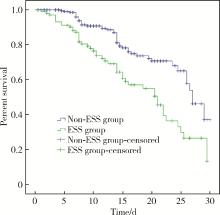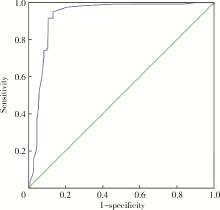Journal of Peking University (Health Sciences) ›› 2024, Vol. 56 ›› Issue (3): 526-532. doi: 10.19723/j.issn.1671-167X.2024.03.021
Previous Articles Next Articles
Related factors of euthyroid sick syndrome in patients with sepsis
Yuanyuan ZENG,Yun XIE,Daonan CHEN,Ruilan WANG*( )
)
- Department of Emergency And Critical Care, Shanghai General Hospital of Nanjing Medical University, Shanghai 201620, China
CLC Number:
- R459.7
| 1 |
Xie J , Wang H , Kang Y , et al. The epidemiology of sepsis in Chinese ICUs: A national cross-sectional survey[J]. Crit Care Med, 2020, 48 (3): e209- e218.
doi: 10.1097/CCM.0000000000004155 |
| 2 |
Rodriguez-Perez A , Palos-Paz F , Kaptein E , et al. Identification of molecular mechanisms related to nonthyroidal illness syndrome in skeletal muscle and adipose tissue from patients with septic shock[J]. Clin Endocrinol (Oxf), 2008, 68 (5): 821- 827.
doi: 10.1111/j.1365-2265.2007.03102.x |
| 3 | Reichlin S , Bollinger J , Nejad I , et al. Tissue thyroid hormone concentration of rat and man determined by radiommunoassay: Biologic significance[J]. Mt Sinai J Med, 1973, 40 (3): 502- 510. |
| 4 |
Fliers E , Bianco AC , Langouche L , et al. Thyroid function in critically ill patients[J]. Lancet Diabetes Endocrinol, 2015, 3 (10): 816- 825.
doi: 10.1016/S2213-8587(15)00225-9 |
| 5 | Martinez Quintero B , Yazbeck C , Sweeney LB . Thyroiditis: Evaluation and treatment[J]. Am Fam Physician, 2021, 104 (6): 609- 617. |
| 6 |
Debaveye Y , Ellger B , Mebis L , et al. Regulation of tissue iodothyronine deiodinase activity in a model of prolonged critical illness[J]. Thyroid, 2008, 18 (5): 551- 560.
doi: 10.1089/thy.2007.0287 |
| 7 |
Singer M , Deutschman CS , Seymour CW , et al. The third international consensus definitions for sepsis and septic shock (sepsis-3)[J]. JAMA, 2016, 315 (8): 801- 810.
doi: 10.1001/jama.2016.0287 |
| 8 |
中华医学会内分泌学分会. 成人甲状腺功能减退症诊治指南[J]. 中华内分泌代谢杂志, 2017, 33 (2): 167- 180.
doi: 10.3760/cma.j.issn.1000-6699.2017.02.018 |
| 9 | El-Ella SSA , El-Mekkawy MS , El-Dihemey MA . Prevalence and prognostic value of non-thyroidal illness syndrome among critically ill children[J]. An Pediatr (Engl Ed), 2019, 90 (4): 237- 243. |
| 10 |
Foks M , Dudek A , Polok K , et al. Thyroid hormones as potential prognostic factors in sepsis[J]. Anaesthesiol Intensive Ther, 2019, 51 (3): 205- 209.
doi: 10.5114/ait.2019.86883 |
| 11 |
Liu YC , Jiang TY , Chen ZS , et al. Thyroid hormone disorders: A predictor of mortality in patients with septic shock defined by Sepsis-3[J]. Intern Emerg Med, 2021, 16 (4): 967- 973.
doi: 10.1007/s11739-020-02546-2 |
| 12 |
Lamba N , Liu C , Zaidi H , et al. A prognostic role for Low triiodothyronine syndrome in acute stroke patients: A systematic review and meta-analysis[J]. Clin Neurol Neurosurg, 2018, 169, 55- 63.
doi: 10.1016/j.clineuro.2018.03.025 |
| 13 |
Guo J , Hong Y , Wang Z , et al. Analysis of the Incidence of euthyroid sick syndrome in comprehensive intensive care units and related risk factors[J]. Front Endocrinol (Lausanne), 2021, 12, 656641.
doi: 10.3389/fendo.2021.656641 |
| 14 |
Qu C , Duan Z , Xiao X , et al. Nonthyroidal illness syndrome in acute pancreatitis patients: An 8-year cohort study[J]. BMC Gastroenterol, 2022, 22 (1): 40.
doi: 10.1186/s12876-022-02111-5 |
| 15 |
Fliers E , Bianco AC , Langouche L , et al. Thyroid function in critically ill patients[J]. Lancet Diabetes Endocrinol, 2015, 3 (10): 816- 825.
doi: 10.1016/S2213-8587(15)00225-9 |
| 16 |
韩刚, 乔小放, 马志明. 腹腔感染合并甲状腺功能低下的诊治[J]. 中华胃肠外科杂志, 2018, 21 (12): 1356- 1360.
doi: 10.3760/cma.j.issn.1671-0274.2018.12.005 |
| 17 |
Gao L , Liu X , Zhang D , et al. Early diagnosis of bacterial infection in patients with septicopyemia by laboratory analysis of PCT, CRP and IL-6[J]. Exp Ther Med, 2017, 13 (6): 3479- 3483.
doi: 10.3892/etm.2017.4417 |
| 18 | 王仲, 魏捷, 朱华栋, 等. 中国脓毒症早期预防与阻断急诊专家共识[J]. 临床急诊杂志, 2020, 21 (7): 519- 529. |
| 19 |
易晓榕, 桂晓美. 肝素结合蛋白用于诊断脓毒症的研究[J]. 实验与检验医学, 2017, 35 (5): 654- 657.
doi: 10.3969/j.issn.1674-1129.2017.05.006 |
| 20 |
Borobia AM , Carcas AJ , Arnalich F , et al. A cohort of patients with COVID-19 in a major teaching hospital in Europe[J]. J Clin Med, 2020, 9 (6): 1733.
doi: 10.3390/jcm9061733 |
| 21 | 张艳平, 周鹂婕. C反应蛋白联合降钙素原对慢性阻塞性肺病急性加重期中细菌感染的诊疗价值[J]. 中南大学学报(医学版), 2014, 39 (9): 939- 943. |
| 22 |
Fu L , Long W , Liu T , et al. Decreased circulating levels of free triiodothyronine in sepsis children and correlation analysis[J]. BMC Pediatr, 2022, 22 (1): 687.
doi: 10.1186/s12887-022-03756-7 |
| 23 |
Huang J , Zhang J , Wang F , et al. Association between comorbid asthma and prognosis of critically ill patients with severe sepsis: A cohort study[J]. Sci Rep, 2021, 11 (1): 15395.
doi: 10.1038/s41598-021-93907-0 |
| 24 |
Ilera V , Delfino LC , Zunino A , et al. Correlation between inflammatory parameters and pituitary-thyroid axis in patients with COVID-19[J]. Endocrine, 2021, 74 (3): 455- 460.
doi: 10.1007/s12020-021-02863-2 |
| 25 |
de Vries EM , Fliers E , Boelen A , et al. The molecular basis of the nonthyroidal illness syndrome[J]. Endocrinol, 2015, 225 (3): R67- R81.
doi: 10.1530/JOE-15-0133 |
| 26 |
Lui DTW , Lee CH , Chow WS , et al. Thyroid dysfunction in relation to immune profile, disease status and outcome in 191 patients with COVID-19[J]. Clin Endocrinol Metab, 2021, 106 (2): e926- e935.
doi: 10.1210/clinem/dgaa813 |
| 27 |
Wang W , Su X , Ding Y , et al. Thyroid function abnormalities in COVID-19 patients[J]. Front. Endocrinol, 2021, 11, 623792.
doi: 10.3389/fendo.2020.623792 |
| 28 | Mancini A , Di Segni C , Raimondo S , et al. Thyroid hormones, oxidative stress, and Inflammation[J]. Mediators Inflamm, 2016, 2016, 6757154. |
| 29 |
Castro I , Quisenberry L , Calvo RM , et al. Septic shock non-thyroidal illness syndrome causes hypothyroidism and conditions for reduced sensitivity to thyroid hormone[J]. J Mol Endocrinol, 2013, 50 (2): 255- 266.
doi: 10.1530/JME-12-0188 |
| 30 |
Asai K , Shirakabe A , Kiuchi K , et al. Relation of Low triiodothyronine syndrome associated with aging and malnutrition to adverse outcome in patients with acute heart failure[J]. Am J Cardiol, 2020, 125 (3): 427- 435.
doi: 10.1016/j.amjcard.2019.10.051 |
| 31 |
Gutch M , Kumar S , Gupta KK . Prognostic value of thyroid profile in critical care condition[J]. Indian J Endocrinol Metab, 2018, 22 (3): 387- 391.
doi: 10.4103/ijem.IJEM_20_18 |
| 32 |
Rothberger GD , Valestra PK , Knight K , et al. Low free T(3) is associated with worse outcomes in patients in the ICU requiring invasive mechanical ventilation[J]. J Intensive Care Med, 2021, 36 (3): 313- 318.
doi: 10.1177/0885066619890822 |
| 33 |
徐梅先, 刘刚, 曹利静, 等. 脓毒症危重患儿非甲状腺疾病综合征的发生及其与IL-6和IL-10的相关性[J]. 中国当代儿科杂志, 2020, 22 (11): 1215- 1220.
doi: 10.7499/j.issn.1008-8830.2004137 |
| 34 |
徐亚楠, 王栋, 刘欢. 脓毒症患者血脂与炎症因子水平的相关性研究[J]. 中华危重病急救医学, 2022, 34 (2): 127- 132.
doi: 10.3760/cma.j.cn121430-20211105-01646 |
| 35 |
Tuculeanu G , Barbu EC , Lazar M , et al. Coagulation disorders in sepsis and COVID-19: Two sides of the same coin? A review of inflammation-coagulation crosstalk in bacterial sepsis and COVID-19[J]. J Clin Med, 2023, 12 (2): 601.
doi: 10.3390/jcm12020601 |
| 36 |
Kendall H , Abreu E , Cheng AL . Serum albumin trend is a predictor of mortality in ICU patients with sepsis[J]. Biol Res Nurs, 2019, 21 (3): 237- 244.
doi: 10.1177/1099800419827600 |
| 37 |
Arnau-Barrés I , Güerri-Fernández R , Luque S , et al. Serum albumin is a strong predictor of sepsis outcome in elderly patients[J]. Eur J Clin Microbiol Infect Dis, 2019, 38 (4): 743- 746.
doi: 10.1007/s10096-019-03478-2 |
| 38 |
Pan B , Du X , Zhang H , et al. Relationships of chronic kidney disease and thyroid dysfunction in non-dialysis patients: A pilot study[J]. Kidney Blood Press Res, 2019, 44 (2): 170- 178.
doi: 10.1159/000499201 |
| 39 |
Li LZ , Hu Y , Ai SL , et al. The relationship between thyroid dysfunction and nephrotic syndrome: A clinicopathological study[J]. Sci Rep, 2019, 9 (1): 6421.
doi: 10.1038/s41598-019-42905-4 |
| 40 |
Wang C , Han S , Li Y , et al. Value of FT3/FT4 ratio in prognosis of patients with heart failure: A propensity-matched study[J]. Front Cardiovasc Med, 2022, 9, 859608.
doi: 10.3389/fcvm.2022.859608 |
| 41 |
张剑, 陈煜, 段钟平. 血清游离三甲碘状腺原氨酸水平预测HBV相关慢加急性肝衰竭患者预后的价值分析[J]. 临床肝胆病杂志, 2022, 38 (1): 81- 85.
doi: 10.3969/j.issn.1001-5256.2022.01.012 |
| [1] | Min WANG, Qian LI. Path analysis of influencing factors of mental resilience in adolescents with depression [J]. Journal of Peking University (Health Sciences), 2024, 56(5): 809-814. |
| [2] | Junyong OU,Kunming NI,Lulin MA,Guoliang WANG,Ye YAN,Bin YANG,Gengwu LI,Haodong SONG,Min LU,Jianfei YE,Shudong ZHANG. Prognostic factors of patients with muscle invasive bladder cancer with intermediate-to-high risk prostate cancer [J]. Journal of Peking University (Health Sciences), 2024, 56(4): 582-588. |
| [3] | Shuai LIU,Lei LIU,Zhuo LIU,Fan ZHANG,Lulin MA,Xiaojun TIAN,Xiaofei HOU,Guoliang WANG,Lei ZHAO,Shudong ZHANG. Clinical treatment and prognosis of adrenocortical carcinoma with venous tumor thrombus [J]. Journal of Peking University (Health Sciences), 2024, 56(4): 624-630. |
| [4] | Le YU,Shaohui DENG,Fan ZHANG,Ye YAN,Jianfei YE,Shudong ZHANG. Clinicopathological characteristics and prognosis of multilocular cystic renal neoplasm of low malignant potential [J]. Journal of Peking University (Health Sciences), 2024, 56(4): 661-666. |
| [5] | Zezhen ZHOU,Shaohui DENG,Ye YAN,Fan ZHANG,Yichang HAO,Liyuan GE,Hongxian ZHANG,Guoliang WANG,Shudong ZHANG. Predicting the 3-year tumor-specific survival in patients with T3a non-metastatic renal cell carcinoma [J]. Journal of Peking University (Health Sciences), 2024, 56(4): 673-679. |
| [6] | Yangyi FANG,Qiang LI,Zhigao HUANG,Min LU,Kai HONG,Shudong ZHANG. Well-differentiated papillary mesothelial tumour of the tunica vaginalis: A case report [J]. Journal of Peking University (Health Sciences), 2024, 56(4): 741-744. |
| [7] | Xiaohan LIU,Fan YANG,Xindi WANG,Ning HUANG,Taozhu CHENG,Jing GUO. Related factors and equity of health status among floating population in China based on geographic information system analysis [J]. Journal of Peking University (Health Sciences), 2024, 56(2): 223-229. |
| [8] | Silan AN,Qunyi ZHENG,Kai WANG,Shan GAO. Characteristics and influencing factors of early pain in patients after total knee arthroplasty [J]. Journal of Peking University (Health Sciences), 2024, 56(1): 167-173. |
| [9] | Jian-bin LI,Meng-na LYU,Qiang CHI,Yi-lin PENG,Peng-cheng LIU,Rui WU. Early prediction of severe COVID-19 in patients with Sjögren’s syndrome [J]. Journal of Peking University (Health Sciences), 2023, 55(6): 1007-1012. |
| [10] | Huan-rui LIU,Xiang PENG,Sen-lin LI,Xin GOU. Risk modeling based on HER-2 related genes for bladder cancer survival prognosis assessment [J]. Journal of Peking University (Health Sciences), 2023, 55(5): 793-801. |
| [11] | Zi-xuan XUE,Shi-ying TANG,Min QIU,Cheng LIU,Xiao-jun TIAN,Min LU,Jing-han DONG,Lu-lin MA,Shu-dong ZHANG. Clinicopathologic features and prognosis of young renal tumors with tumor thrombus [J]. Journal of Peking University (Health Sciences), 2023, 55(5): 802-811. |
| [12] | Zhi-wei LIU,Peng LIU,Fan-xing MENG,Tian-shui LI,Ying WANG,Jia-qi GAO,Zuo-yi ZHOU,Cong WANG,Bin ZHAO. Regulative effects of endogenous sulfur dioxide on oxidant stress in myocardium of rat with sepsis [J]. Journal of Peking University (Health Sciences), 2023, 55(4): 582-586. |
| [13] | Yong-wei LIN,Ya-lin ZHOU,Run-long ZHAO,Ya-jun XU,Yan-ping LIU. Analysis on the iron status and associated factors during the first trimester of pregnancy [J]. Journal of Peking University (Health Sciences), 2023, 55(4): 600-605. |
| [14] | Qiang FU,Guan-ying GAO,Yan XU,Zhuo-hua LIN,You-jing SUN,Li-gang CUI. Comparative study of ultrasound and magnetic resonance imaging in the diagnosis of asymptomatic anterosuperior acetabular labrum tears [J]. Journal of Peking University (Health Sciences), 2023, 55(4): 665-669. |
| [15] | Han LU,Jian-yun ZHANG,Rong YANG,Le XU,Qing-xiang LI,Yu-xing GUO,Chuan-bin GUO. Clinical factors affecting the prognosis of lower gingival squamous cell carcinoma [J]. Journal of Peking University (Health Sciences), 2023, 55(4): 702-707. |
|
||





